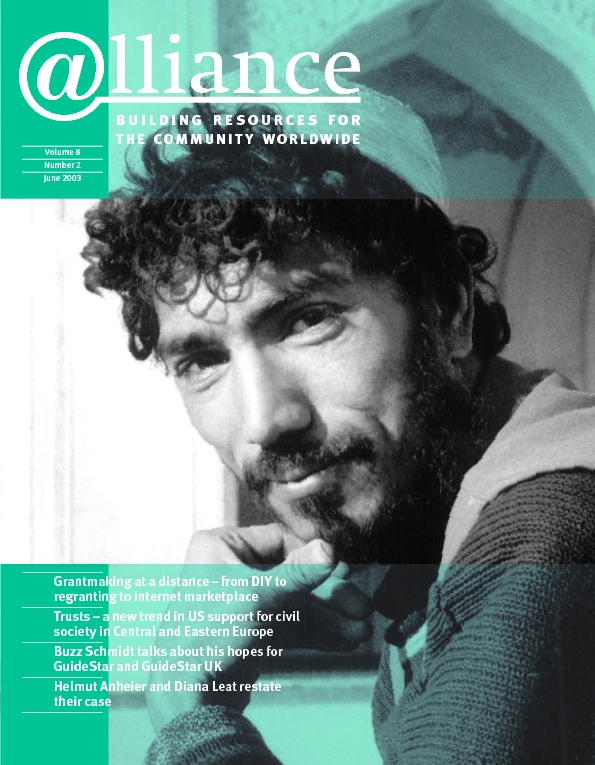In 1997 the Women’s Information Consultative Centre (WICC) in the Ukraine was one of ten women’s organizations selected out of 200 Global Fund for Women grantees for that year to receive a GFW Tenth Anniversary partnership grant for regranting. This gave WICC the chance to break through the ‘glass ceiling’ that tends to prevent very small women’s organizations attracting funds from donors, and proved to be the first step in creating the Ukrainian Women’s Fund.
In 1995, when I participated in the 4th International Conference on Women, the Global Fund for Women (GFW) invited me to conduct a training session on fundraising for a Russian-speaking group. The day before, we were given T-shirts with the GFW logo on them. In the morning, on my way to the session, a woman stopped me and asked if I was from GFW. ‘I am a GFW donor,’ she said proudly.
When telling session participants about this meeting, I said that the woman was probably very rich if she was a donor! Then I saw a vast list of GFW donors – women and men – and learnt that GFW considers people as donors irrespective of whether their donation was $10 or $1 million. I was so impressed by this list that I thought – even then, when the Ukraine was experiencing enormous inflation, industry was stagnating, and the shops were full of exported goods from neighbouring countries – we too could start a foundation to meet the needs of Ukrainian women, gathering money and spreading it in the form of grants.
That’s why, when we heard from San Francisco that our organization, WICC, was to receive a GFW partnership grant, we felt that we had taken a first step towards creating a Ukrainian women’s fund.
Implications of taking on regranting
What did it mean for WICC to give grants to others? What difference did it make to local organizations? What could we do that other donors, even GFW, couldn’t do?
First of all, such empowerment was an absolutely new experience for us. From a practical point of view it meant new procedures. What form should the money be given in? Over what term? What form of reporting should be used? A moral question was ‘how will we change when we begin to represent money?’ (a question that arises in fundraising training). How would attitudes towards us change?
We were very serious in answering all these questions. We thought hard about who we should give grants to, and why. The sum of money available was not large (a partnership grant was $10,000, plus $1,000 for administrative expenses, which we decided to include in the sum available for grants), and Ukrainian women have many needs. We decided not just to do the same as the big donor organizations but rather to try to do things they can’t or don’t want to do.
WICC’s grant programme
In particular, we decided to support non-registered groups and possibly provide money for registration. This wasn’t done by others, even GFW, for a variety of reasons:
- This is possible only if payments that the grant-receiving organization needs to make can be made directly from the donor organization’s account to those who sell goods and services. This is because non-registered entities can’t pay as entities through bank accounts. They are practically invisible and non-existent. This requires much more time and effort than giving the whole grant sum to the grantee.
- It involves a greater risk for the donor: if the grantee is not registered, the donor has fewer guarantees that the project will be implemented according to the proposal to protect the donor if it is not fulfilled.
- The results of supporting such micro-projects won’t be instantly visible to report to the original donors.
One disadvantage of such a programme is that dealing in such small sums of money can cause the grantmaker (in this case WICC), and the organizations it supports, to think only in terms of small sums and small effects. This can create the impression that the programme is unsuccessful. This could slow down development of a new women’s fund and suggest that the idea itself is marginal.
The most significant potential effect of such a programme is that it gives women, in this case both WICC and its grantees, the opportunity to believe in themselves through others believing in them. Research in many countries of the world has shown that women have less access to money than men. This programme helped to create a ‘grant history’ for very small women’s organizations and enabled them to approach other foundations for support. Research also shows that women are more inclined to work in the non-formal economy. This programme helped women’s organizations to register and ‘come out of the shadow’.
When we finished this programme, we decided to take the next step – to establish the Ukrainian Women’s Fund. It was registered on 4 October 2000.
Olena Suslova was one of the founders of the Ukrainian Women’s Fund. She is now chair of the board of WICC and can be contacted at wicc@public.icyb.kiev.ua
For more information about the Ukrainian Women’s Fund, contact Natalya Karbovska, chair of the board, at uwf@uwf.kiev.ua





Comments (0)